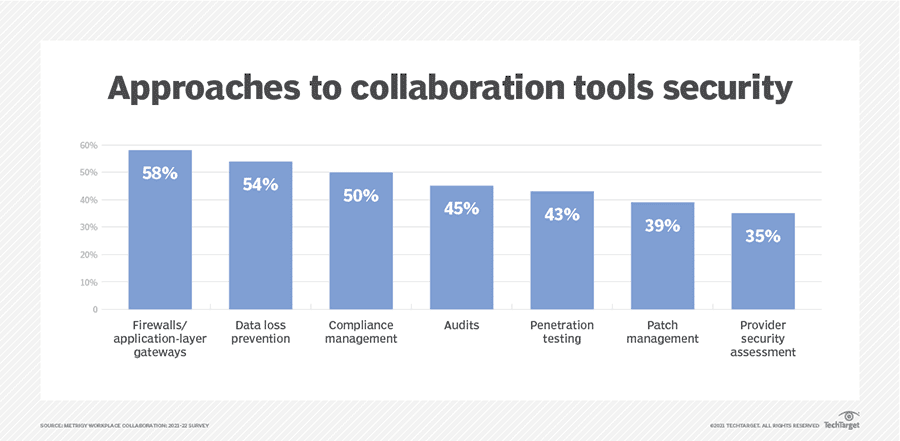6 Tools to Improve Your
Remote Content Team Collaboration
See also: Collaboration Skills
Today’s workplaces are more varied than ever before. This past year saw a huge shift towards the adoption of remote working. Some companies moved fully remote while others adopted a hybrid working model, with some employees working off-site while others remained on-site.
According to Upwork, 2021 will see 26.7% of American workers working remotely, and 85% of managers expect company teams with remote workers to become the norm.
Remote work has its advantages and disadvantages. Some benefits of remote work include 77% of employees considering themselves more productive in remote roles, with 74% of workers becoming more loyal to their company.

More employees work from home.
Traditionally, work required people to operate in the same physical location. Now, however, with so many white-collar jobs being carried out on a computer, employees can work from anywhere with relative ease. And as a result of people working from home, remote-team collaboration is an area that many companies need to focus on, and soon.
Indeed, increasing numbers of companies are adopting work-from-home policies. To adapt, you’ll need to find team collaboration tools that enable your workforce to continue working efficiently. Like others, content teams need to collaborate on several projects at the same time, and it can cause a company to feel insecure when their teams are working remotely. With the right tools, however, your company can have a highly effective remote content team.
This post discusses why team collaboration is essential. It emphasizes six tools that will improve your remote content team collaboration.
Why Team Collaboration Matters?
Team collaboration is a mixture of project management and team collaboration practices aimed at getting the most out of a group of employees. This working style encourages teamwork, innovation, and participation so that your remote content team can achieve its content goals.

Team collaboration improves company performance.
Companies with high levels of team collaboration see many benefits, including more productive meetings, more engaged employees, and improved flexibility. Team collaboration also helps companies and employees align their work goals, increase job satisfaction, and it improves several work-related skills.
Remote teams may have a different experience of your company when compared to other employees, but with the development of new technologies, the differences between remote and on-site team members are narrowing. Your remote content team can collaborate in real-time and produce high-quality works just as well.
Here are six tools that will improve your remote content team collaboration.
1. Audio/Video Conferencing Software
Companies have started to adopt conference-calling software, enabling employees and management to communicate regularly and with ease. Conference-calling software is beneficial for your remote team because they can connect with their whole team from anywhere, simply clicking “unmute microphone” to jump into the call.
There are many other benefits, too. It’s easy to use, giving remote workers better meeting experiences, whether discussing complex content like call center optimization, or just for team catch-ups. Some software offers security across communication channels, and some include tools enable your team to recognize which people are talking.

Video conference calling software
There have been many tweaks to the use of video conferencing culture over the last year. Some remote workers found that video conferencing can be intrusive when at home. However, some features, like screen sharing, can be very beneficial. Many video conferencing tools allow you to share a whiteboard or an open window. That way, you can share presentations and work as you communicate with the remote content team.
Your remote team members may want to consider their internet speeds and bandwidth. You need stable internet to enable your conference calling software. Using VoIP routers, your remote team members should be able to enjoy high internet speeds, enabling the content team to hear each other clearly and to be confident their video and screen shares will transmit without much lag.
2. Team Chat Software
Instant messaging and team chat software is among the top five business communication tools. Like other communication tools, instant messaging software is valuable for a remote content team. Instant messaging software allows your team to collaborate more quickly. They can communicate project details immediately and without the need to get on a call.
Instant messaging tools can be excellent for productivity among your workers, lowering the number of interruptions your remote content team will experience as they work. It takes little to no effort to open a chat, write a quick message, and continue working. Your remote team will not be meeting people to have water-cooler chats. Instead, they can spend more time focusing on the tasks at hand.
Instant messaging and team chat tools are time and cost-efficient ways to communicate. There are a variety of different messaging tools you could adopt, depending on the features required and the scale of your business. For example, some instant messaging tools offer unlimited messaging for very affordable prices and can scale well with the size of your company.
There can, however, be security concerns with instant messaging. 71% of office workers share sensitive data at the office—and that happens through instant messaging and team collaboration software. Some employees share client information, HR issues, and other data; and it’s clearly in a company’s best interests to secure its communications.
3. Work Management Software
Work and project management issues cost you over 10% of your investment, and challenges that impact a company’s productivity impact their return on investment. There are likely to be at least several content-creating teams in your niche. As the teams compete for similar audiences, your remote team needs to produce the best work in the shortest amount of time.
Work management software is beneficial in every workplace. Your remote content teams can use work management tools to manage workflows, using these tools to keep track of their projects in order to improve their productivity. They allow the content team to track, organize, plan, and review content as they produce. Work management software can also be helpful with version control, enabling teams to revert changes made.

Software to track files and documents
Work management tools are excellent ways for remote content teams to monitor their work from beginning to end, and they can enable team leaders to keep track of all the resources being used throughout their projects. If, for example, you’re producing content about call center software, you’ll need your content designers, writers, editors, and content manager in full alignment with content goals.
Like work management software, your remote content team can also use workstream software to improve collaboration between team members and for streamlining task management. These tools enable your team to know their responsibilities, the tasks they need to complete, and to track assignments easily.
4. Filesharing Software
Remote team collaboration has never been easier thanks to the filesharing solutions available today. Whether you use Google Drive, Dropbox, or Trello, there are several options when considering collaboration software. Filesharing software enables your remote teams to work seamlessly—despite their geographic distances and varying time zones, people can collaborate.
The most suitable software will depend on the requirements of your remote content team. Is your team full of writers? You may consider a tool like Google Docs. If they are designers or video editors, you may prefer WeTransfer. Filesharing software enables your team to share projects quickly and easily. They determine the storage location of their files and submit them through a portal.
One reason for adopting filesharing software is the speed of transfer. Remember the days when you would carry a flash disk or hard drive around just to collect files for work? No matter the file size, you can transfer work within minutes. And most filesharing software comes with layers of protection—as your remote content team transfers work online, they will rest easy knowing their data and work are secure.
5. Remote Desktop Software
Remote desktop applications are beneficial for your hybrid or remote workplace. These applications enable employees to connect to computers set in other secure locations, meaning workers operating from home or different geographic locations can connect to your computers at the company’s campus.
Several of your colleagues may have transitioned from being in the office to working remotely, but there could be files and projects you need on their office computer. Remote desktop applications allow your remote team to access their assignments on their office computers with ease. This can be valuable when troubleshooting or showcasing a project.
Remote desktop applications can be useful for remote content team collaboration in situations where screen sharing or mirroring may be needed, and managers may find these tools helpful when monitoring work.
Imagine a remote content team was creating an extensive video tutorial collection. Depending on the screen resolution, the original file size of such a video could be huge; and in normal circumstances, it would be a challenge to transfer the original data. However, by mirroring the office desktop, your remote team can copy the original files without much effort.
6. Security Tools
Remote content teams collaborate through different tools. As such, many companies need to take on some security considerations. Security breaches can be expensive, so a company must have the best security to protect it from cyberattacks. This will mitigate risks from leaky information and reduce liabilities. Invest in creating secure environments and content management systems that meet security standards.
Remote teams can work safely when your company adopts the most secure tools. For example, just like call center software, many communication tools offer end-to-end encryption, meaning your remote content team can discuss the intimate details of your projects without worrying about people tapping into your communications channel.
Team collaboration software can have different levels of security. Some software is highly secure and enables your remote team to work confidently. Other software can have lower levels of security. As a result, they may not meet your company’s requirements. Companies constantly face digital risks. These include toll fraud attacks, denial of service attacks, and more.

Approaches to collaboration tools security
There are several ways to address security concerns concerning collaboration software. In the graphic above, you can see methods that companies have tried to manage collaboration-tool security. The more secure your collaboration tools, the more confident the company will be about your remote content team collaboration. Protection means safe data transfers and safe working environments for everyone.
Remote Collaboration Tools
Try the six types of tool highlighted in this post. They will improve your remote content team collaboration by providing great communications channels and better means of file transferring. In addition, these tools will allow your remote content teams to open projects from any location. As such, they can access their work machines where necessary.
These team collaboration tools enable management, leaders, and team members to keep track of their work. Through them, you outline work responsibilities. They also provide security for the projects, documents, and communication between team members. Work is easier when every member is on the same page.
Add these tools to your company’s repertoire. They will enable and improve your remote content team collaboration. That means your remote content team can increase their productivity and maintain open communication channels at all times. Your company will enjoy an increased number of ideas and successful content campaigns. Put these tools in place and get creative.
About the Author
Jessica Day is the Senior Director for Marketing Strategy at Dialpad. Jessica is an expert in collaborating with multifunctional teams to execute and optimize marketing efforts, for both company and client campaigns.
